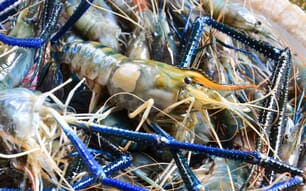Identity
Cherax quadricarinatus von Martens, 1868 [Parastacidae]. FAO Names: En - Red Claw Crayfish, Fr - , Es -
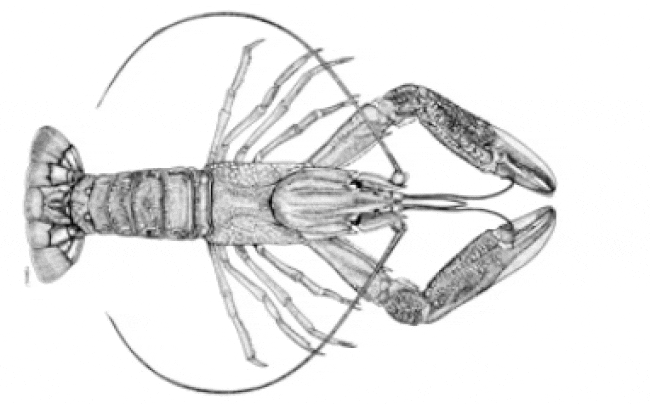
Biological features
Relatively large freshwater crayfish, smooth lustrous deep blue to green shell, with males exhibiting bright red colouring on the margins of their large claws.
Males can reach a maximum weight of 500g and females 400g. Juveniles (less than 20 to 30g) can be sexually distinguished by the gonopore position, adjacent to the fifth pereiopods (walking legs) for males and third legs for females. Distinguished from other crayfish by size, colour and the presence of four distinct anterior ridges (carinae) of the carapace.

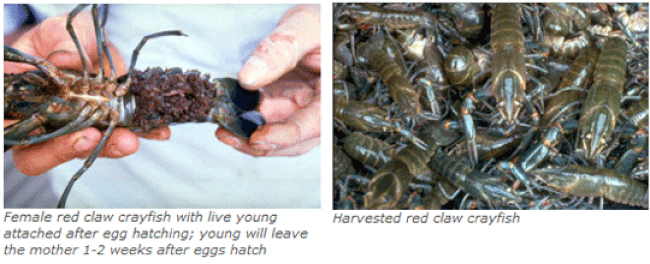
Profile
Historical background
The red claw crayfish (Cherax quadricarinatus), referred to throughout the rest of this fact sheet simply by its Australian synonym "redclaw", is a tropical species native to the rivers of north-west Queensland and the Northern Territory in Australia. Although well known to the local inhabitants of this isolated region, it remained effectively unknown to the rest of the world until the late 1980s, when it was trialled for aquaculture. Redclaw proved to be well suited to cultivation, and the redclaw aquaculture industry was born, developing quickly and spreading throughout northern Australia, and soon afterwards overseas.
Redclaw benefits from a host of physical, biological and commercial attributes that make it an excellent candidate for aquaculture. It is physically robust with broad geographic potential, has a simple life-cycle and straightforward production technology, requires low protein diet and is economic to produce. Its texture and flavour compares very favourably with commonly eaten marine crustaceans and, having the appearance of a lobster, is positioned at the premium end of the crustacean market spectrum.
Although indigenous to Australia, redclaw has been exported to many other countries where commercial production has now been established. Production technologies, while still evolving, are at a stage where "best management practice" methods have been identified. These technologies are relatively straightforward and the skill levels required of practitioners are not onerous.
Redclaw aquaculture has been established now for more than 25 years, and yet total production is still quite small. This is despite many projections that it would become a significant aquaculture species worldwide, and possibly a rival of the giant freshwater prawn (Macrobrachium rosenbergii).
Main producers
Besides the countries shown in the map, based on FAO statistical returns, redclaw farming activities are also known to exist in Belize, China, Indonesia, Israel, Morocco, Panama, Spain and the USA. Unconfirmed reports of interest in several other countries also exist.
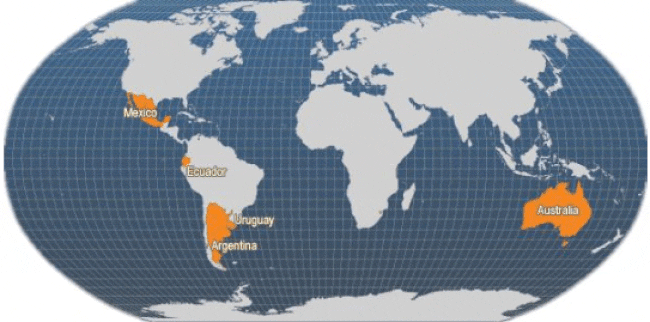
© FAO Fishery Statistics, 2008
Habitat and biology
Redclaw is native to the upper reaches of rivers in northeastern Australia, and in Papua New Guinea. Its preferred habitat is in high turbidity, slow moving streams or static water holes (billabongs) that characterise the rivers in that region. These are flushed seasonally with monsoonal wet season rains, which may wash the redclaw downstream.
Redclaw display a strong tendency to move upstream to the preferred habitat, and to avoid being stranded in the lower river reaches that often dry up in the dry season. Its adaptation to the natural habitat has generated a host of biological attributes that are well suited to aquaculture, as summarised below:
- Breeds easily, with no larval stage development
- Potential for selective breeding; many wild population strains
- Tolerates high stocking densities
- Requires low protein diet, not reliant on fishmeal
- Market position as a high value crustacean
- Flesh texture and flavour compares favourably with other crustaceans
- Meat recovery rate acceptable
- Reaches commercial size in nine months grow-out
- Survives well out of water for transport to market
- Straightforward production technology
- Tolerant of variations in water quality - low dissolved oxygen, wide daily pH changes, low alkalinity, temperature variations, high nutrient loads
- Tolerates saline water up to 5 percent indefinitely and up to 15 percent for several days. This provides broad geographic potential and a means of enhancing flavour, purging and cleaning before sending to market
- No destructive burrowing
- Non aggressive – cannibalism not regarded as an issue
Redclaw is a tropical species endemic to northeastern Australia. The harsh physical extremes of this distribution have given this species a robust nature with broad climatic tolerances.
Its preferred temperature range is 23ºC to 31ºC and it will perish at 36ºC. Reproduction will only occur while water temperature remains above 23ºC.
Female redclaw brood their eggs for six-ten weeks, depending on temperature. Most produce between 300 and 800 eggs per brood. There may be between three to five broods during the breeding season. Hatchlings resemble the adult form and remain attached to the underside of the female for several weeks before progressively becoming independent.
Production
Production Cycle
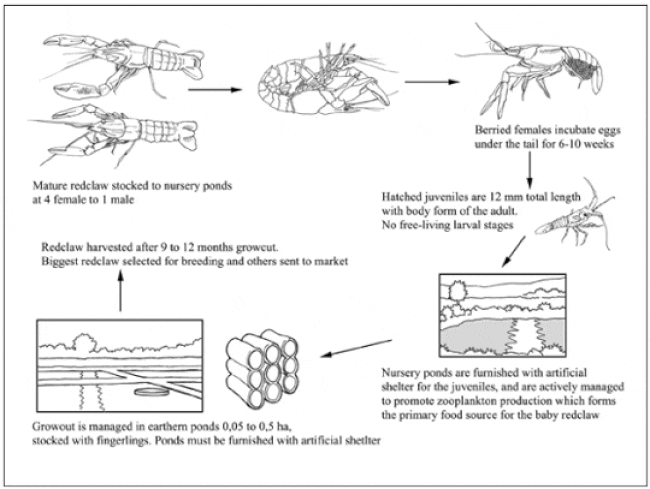
Production systems
Seed supply
Selected berried females or mature broodstock from the harvests of grow-out ponds are stocked into juvenile rearing ponds. Breeding and production of seed occurs naturally during the summer months, when temperatures are >25ºC.
Hatchery production
There is no hatchery production. Redclaws are reared directly in the juvenile ponds.
Juvenile production
Juvenile production and grow-out to market size are managed separately, although both are performed in earthen ponds. A managed juvenile production programme is essential to provide the advanced juveniles required for grow-out, and to make effective use of the superior broodstock selected. Depending on temperature and whether berried females or mature broodstock are used, a culture period of three to four months is necessary to achieve a mean size of juveniles of 5 to 15g.
The two most critical factors in juvenile production are the provision of shelter and food. The general management of juvenile rearing ponds is the same as that described in this fact sheet under on-growing techniques.
Typically juvenile ponds are stocked with mature females and males at a ratio of 4:1 and a density of 1,500/ha, carefully selected as the best of the stock available from grow-out harvest.
Under well managed conditions, 50-100 advanced juveniles will be produced per broodstock female, providing a yield of 60,000 to 120,000 juveniles/ha. At water temperatures above 25ºC, a juvenile production pond stocked with male and female broodstock is ready for harvest in four months. Alternatively, when berried females are stocked, the juvenile production pond is ready to harvest in three months.
To maximise survival and growth of the juvenile redclaw, an abundance of shelter in the ponds is essential. This is usually provided in the form of bundles of synthetic mesh, tied onto a line with a weight at one end and a float at the other. Arranged in this manner, these bundles extend from the pond floor up into the water column providing many spaces and surfaces for the juveniles to utilise. These mesh bundles are stocked at one every 5m2.
Juvenile production ponds are carefully managed to provide an abundance of planktonic organisms which the juvenile crayfish utilise as food. The planktonic organisms include both phytoplankton and zooplankton; it is primarily the latter that are consumed by the juvenile crayfish. As they grow, they progressively consume less plankton and more of the detrital food that occurs on the surface of the shelter material and, more especially, on the mud surface.
Maintaining high levels of plankton involves regular checking of water quality and periodic fertilisation of the water with nitrogen and phosphorus (typically diammonium phosphate at 50 kg/ha).
Harvesting of the juveniles is achieved by a number of methods. Sometimes individual mesh shelters are removed and the juveniles shaken out. However, the most effective method is to employ a flow trap. With this method, the pond is completely drained and all the crayfish are attracted into a trap. From there they can be removed to tanks and sorted, counted and then stocked into the grow-out ponds.
On-growing techniques
Although all commercial redclaw grow-out occurs in earthen ponds, there is some interest in tank culture.
Ponds
Redclaw aquaculture, both in juvenile and grow-out ponds, is performed in earthen ponds, typically 0.05 to 0.5ha, with a depth of 1.0-2.5m and a V-shape that allows rapid and complete drainage. Water is sourced from surface supplies or underground and should have a pH of 6.5-8.0, hardness of >40ppm, and low levels of salinity (artificial shelters are essential; they should be abundant, and their shape, specification and positioning should permit water to drain out freely and completely as the pond is drained. Stacks of pipes have been found to provide the most effective shelter for redclaw in the grow-out phase.
Aeration is also essential and most frequently provided through airlift pumps, although other forms of aeration such as paddle-wheels and aspirators may be used. The aeration system should provide both oxygen input to the water and water circulation from bottom to top and around the pond.
Fencing and netting over ponds is essential in areas where predatory birds and other species are prevalent. Grow-out ponds should be prepared with applications of lime, inorganic fertilisers and some organic material such as hay or manure. This initiates a plankton bloom, which provides additional, highly nutritious food and minimises light penetration.
Grow-out necessitates an active stock management approach. Because redclaw breed so readily and profusely, the pond populations must be managed intensively. This includes stocking with known numbers of advanced juveniles of at least 5g. Uniformity of size is very important. Maximum size at stocking should be 10g. Stocking densities of 5-15/m2 are recommended.
The food used will have an important bearing on production. Commercial crayfish pellets are available and have proven to be effective. A feeding frequency of once per day is adequate, preferably at dusk when crayfish are active.
Active management of the pond environment is essential to maximise yields. There should be weekly monitoring of pH, dissolved oxygen and transparency (secchi disk) and monthly monitoring of hardness, alkalinity and ammonia.
All measurements must be made at the water/soil interface on the bottom, and a contingency plan must be developed to counter poor water quality by applications of lime or fertiliser, or flushing of the pond with fresh water.
Drying both juvenile and grow-out ponds between crops is essential to sterilise and re-vitalise the bottom. There is often a considerable build-up of organic waste after a culture period. The most effective management is to dry the pond for one to two weeks until cracks appear. Toxic compounds are broken down and useful nutrients are released.
Crayfish may be manually sexed and stocked into separate ponds, particularly those that are to be grown out to >50g. Avoiding, or at least minimising reproduction in grow-out ponds is important in effective management.
Protection against birds, rats and eels, and any other potential predators must be provided. Complete enclosure netting and fencing is essential. Recent economic analysis indicated that the cost of netting (including materials and installation) is equivalent to 15 percent of the value of one crop. As losses to predators may be well in excess of this, netting is very cost-effective.
The maximum grow-out period without grading should be six to nine months to minimise the possibility of un-managed reproduction. At each harvest, the stock must be size-graded and re-distributed as breeding stock, for marketing, for further grow-out or to be culled and discarded.
The runts of each crop are unlikely to achieve market size in a reasonable time and it is best to remove them (and therefore their inferior genetics) from the farm population.
The key factors for redclaw grow-out are
- maximise growth and survival
- avoid reproduction
If these principles are applied, an average yield of more than 5 tonnes/ha/crop should be achieved.
Tanks
Despite the focus of redclaw grow-out being earthen pond systems, there has been regular interest in the use of tank systems. These require only a modest investment in comparison with pond construction, and have therefore attracted great attention.
Unfortunately, tank systems are not likely to provide profitable returns. Redclaw obtains the bulk of its food from decaying matter and associated microbes contained in the pond bottom mud. Although manufactured feeds have been developed for redclaw they do not appear to sustain acceptable growth rates in tank systems.
Similarly, juvenile redclaw, which have slightly different feeding habits to the adults, cannot be cultured successfully in tanks because appropriate food cannot be provided. As a result, the juvenile redclaw become cannibalistic, leaving very few survivors.
The level of production likely from redclaw culture in tanks would return considerably less than the operating costs, and certainly far less than the setup costs. Efforts to develop successful commercial tank systems for the cultivation of freshwater crayfish have a considerable history. Both in Australia and overseas, years of work have been applied to this approach, and yet the only commercially viable operations for redclaw are earthen pond based. There exists no confirmed or documented case of commercial success for crayfish production in a tank system.
Feed supply
Commercial crayfish pellets are available in some countries, although in many cases pellets formulated for other species are used. The most effective have a protein content of ~25 percent and a lipid content of 8 percent, and are composed primarily of grains. Use of a feeding schedule is critical. Suitable alternatives to crayfish pellets include freshwater prawn (Macrobrachium) or fish pellets.
Harvesting techniques
Harvesting may involve a number of methods, although the most effective is the use of a flow-trap; this exploits the strong response of redclaws to flowing water.
A slow but steady flow of water into the pond via a box and ramp illicit movement of crayfish against the flow and into the box. Flow-trapping should involve 95 percent drainage of the pond over 24 hours from dawn to dawn.
There should be several thousand litres of water remaining in the deepest part of the pond at dawn, when the redclaw are removed. This slow drainage enables the crayfish to move out of shelters and with the main body of water, so that they concentrate and respond most effectively to the flow trap. Both the flow trap and the last remaining water must be well aerated or the entire harvest may easily be lost.
The stock should be quickly removed and transported to clean water in a tank system. Care should be taken to minimise crushing by not exceeding 15kg of stock per transport container (typically a 60 x 40 x 40cm fish basket). Other harvesting methods include bait trapping and drain harvesting with manual collection of stock.
Handling and processing
The majority of redclaw are sold live; thus after harvesting stock they are held in tanks with flow-through water supply or a recirculation system involving biological filtration. A period of at least 24 hours in the tank to permit purging of the gut is recommended prior to packing for transport.
Redclaw can survive extended periods out of water provided they are kept cool and moist. Packing therefore involves insulated containers containing some moist packing material (foam rubber or wood shavings) and cooling packs.
Production costs
A redclaw aquaculture economic model has been developed with data gathered from commercial farms. This model involves a farm size of forty 1,000m2 grow-out ponds and seven 1,000m2 juvenile production ponds, representing a total pond area of 4.7 hectares. The financial evaluation uses a discounted cash flow technique over a 20 year period. The model farm was assumed to annually harvest 394kg of redclaw per grow-out pond from year two onwards.
Redclaw were estimated to take nine months to reach the acceptable market size of 65g mean weight. At this weight the farm-gate price was estimated to be US$12.50/kg.
Initial establishment of the model farm was estimated to cost US$325,000. Included in this cost were land, hired labour, machinery and all farm infrastructure costs. Specifications for the farm layout and pond characteristics were based on "best management practice" recommendations.
In this model farm, redclaw aquaculture was profitable, providing a profit of US$4.91/kg/year. The total costs of production were estimated to be US$7.71/kg/year. Included in these costs were all operating costs, capital costs and allowance for the owner’s labour and management. The discounted payback period, which represents the time to recover the initial outlay, was four years. Sensitivity analyses for prices and yield showed that, at the annual yield of 394kg per grow-out pond, the minimum price for the investment to be profitable was US$7.71/kg.
Similarly, at an assumed price of US$12.50/kg, the minimum annual yield required to be profitable was 2,320 kg/ha. Grow-out periods may vary between 6 months and 15 months depending on the redclaw market weight the grower intends selling. Redclaw market weights and prices were assumed to increase with longer turnoff periods. Based on a sensitivity analysis which compared various grow-out periods, the most profitable option was 9 months and the least profitable was 12 months.
The results from this analysis were very sensitive to prices, survival rates and market weights. Survival rates and market weights are strongly correlated to farm management expertise. Results from established farms applying best practice techniques confirm that the economics of the model are a true and accurate representation of commercial redclaw aquaculture.
Diseases and control measures
Several potentially disease causing organisms, including protozoans, bacteria and viruses, have been identified in redclaw. All have been implicated at one time or another in some mortality or poor production from specific farms, although there has never been any documented widespread outbreak of disease.
Farmers are well aware that careful quarantining and good health monitoring and management will minimise the risk of disease. By maintaining good culture conditions that maximise survival and growth, crayfish stress is managed and the threat of disease minimised.
| Disease | Agent | Type | Syndorme | Measures |
|---|---|---|---|---|
| Systemic Rickettsia | Rickettsia-like organism | Bacteria | Lethargy; poor feed response; low growth rate; significant mortality | For heavy farm infections, complete de-stocking & sterilisation of ponds |
| White tail | >td >Microsporidian | Abdominal muscle becomes opaque; low prevalence but high mortality | Uncommon in farm populations; no specific measures | |
| Redclaw baculovirus | Cherax quadricarinatus bacilliform virus CqBV | Virus | Associated with lethargic & moribund crayfish; high prevalence but low pathogenicity | No specific measures |
Suppliers of pathology expertise
In Australia, the Queensland Government provides a diagnostic service for farm stocks including redclaw crayfish.
Statistics
Production statistics
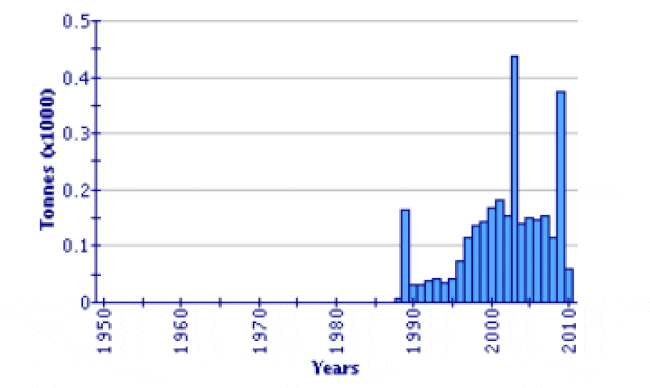
© FAO Fishery Statistic
Annual production of redclaw in Australia has remained at less than 400 tonnes for the past decade through to 2011. The regulatory environment in Australia has stifled investment despite the excellent production credentials of the species.
Meanwhile, in other countries, redclaw production has become established, but with only minor industry growth. In Mexico there is possibly around 50 tonnes of production, but less than ten tonnes each from Belize, Panama and the United States of America.
Ecuador at one stage during the late 1990s had significant redclaw production, particularly for juveniles to stock new farms but this did not persist, and total production is currently negligible. Redclaw farms of substantial scale have been established in Morocco and in Spain, but production from these locations is unknown.
Redclaw have been cultivated in southern China since the mid 1990s, although annual production is said to be less then 100 tonnes (it is not yet specifically recorded in statistical returns to FAO).
Market and trade
Redclaw are commonly marketed in 20g size grades ranging from 30-50g (at approximately US$9.50/kg) to >120g (at approximately US$18.00/kg). The smaller grades are commonly used in buffet style presentations, with the larger animals featuring in a-la-carte restaurants, both as entree and main course dishes.
In Australia, export opportunities have been identified through considerable market research. However, sales to date have been limited by the small production volume and therefore the risk of inconsistent supply. At present 60 percent of redclaw are sold within Queensland and 10 percent sold interstate; the remaining 30 percent exported, primarily to Hong Kong. Production in other countries tends to be marketed locally.
There are three steps in the marketing chain; producer, wholesaler and restaurateur. There are effectively no retail sales of the raw product. While selling direct to restaurants may result in slightly higher prices, the practice can have a limiting effect on market growth.
A good wholesaler can increase the market penetration of redclaw by cross-selling while servicing customers from their existing product lists. Farm-gate sales are substantial; however, the volumes are likely to decrease as more coordinated marketing through wholesalers develops. Wholesalers tend to price redclaw lower than marine lobsters but higher than shrimp. Generally they are marketed alongside slipper lobsters, small spiny lobsters or small clawed marine lobsters.
A clear marketing attribute for Australian redclaw is its reputation as a product from clean water, free of medical or chemical additives. Product is purged prior to sale and is often held in saltwater (up to 15 percent), which improves the flavour and its attractiveness to Asian markets.
Redclaw are mainly sold as a live product, although some processing, particularly cooking and freezing is undertaken. Fresh redclaw have a lustrous shell, deep blue to green in colour. Cooked, they have the bright red appearance typical of premium crustaceans.
Status and trends
A comprehensive research and development programme was operated between 1988 and 2000 by the Queensland Government from a research station at Walkamin. This covered aspects of preliminary assessment, development of production technology, demonstration farms and selective breeding. Research programmes have also operated in the USA (Auburn University, Kentucky State University), Mexico (CIBNOR) and Israel, some of which remain current.
However, while research continues to provide useful information, particularly in regard to nutrition and reproduction, it is not a lack of knowledge that is limiting industry development.
Despite all its positive attributes, the reasons for the lack of redclaw farming expansion remain uncertain. Clearly, market demand for such crustaceans remains strong throughout the world, and freshwater production is generally less exposed to the conflicting resource use issues that face marine aquaculture. Profitability, based on Australian farm modelling, appears to be strong. In Australia the regulatory environment is clearly an obstacle, and the risk of environmental permits not being issued retards investment. Furthermore, the initial apparent success of many small farms that were in fact not of an economically viable scale has resulted in a stagnant industry that is not attractive to new investment.
In other countries, redclaw farming has similarly failed to gain momentum. In many cases the species has been translocated to regions where the climate is simply not suited, such as the USA, where cool winters are not conducive to profitable production. This applies equally to many other countries with sub-tropical environments. Redclaw is a tropical species and thus its farming can only be commercially viable in locations with a tropical climate.
Redclaw farming appeared well suited to Ecuador where development grew quickly from 1994 through 1998, and then promptly collapsed. The reason was purported to be low market price, and therefore lack of profitability.
There have been enough documented cases of high productivity to verify the production capacity of this species. Similarly, market research suggests that acceptable farm-gate prices can be achieved for large volumes that would sustain a viable business. The missing elements appear to be investment in farms of appropriate scale and site selection in tropical locations where the climate will support premium growth. If these criteria are met, redclaw farming may be established and provide a foundation for substantial growth.
Main issues
Redclaw farming faces several marketing challenges. Typical of most new industries, very little promotion has been undertaken, thus consumer awareness internationally is relatively low.
In Australia the industry is composed of a high number of small enterprises making the marketing quite fragmented. Localised marketing groups consisting of several cooperative growers with common purpose have been trialled with limited success. These have established quality standards, brand names and promotional material to more effectively market their collective production in a coordinated manner. The challenge for industry is to increase production through expansion and new investment and to lift production volumes to a point where the substantial quantities required by identified markets can be consistently supplied.
Redclaw is considered an invasive species, and thus its introduction into many areas outside its natural distribution is considered risky. Unfortunately, such translocation has been widespread for more than two decades, and the impacts of this are now being revealed.
To date such impacts appear to be negligible, there being no documented cases of significant ecological consequences such the displacement or competitive exclusion of native species. While the risk remains, and may be manifested in more subtle ways, strict quarantine and security measures should be applied to redclaw farming.
The biological characteristics of redclaw are not typical of a highly invasive species. It has reasonably high sensitivity to low temperature, which precludes its survival in waters where temperature falls below 10ºC. It has a relatively low fecundity and is highly susceptible to predation. Nevertheless, it is a robust species, and every effort should be made to avoid its release into natural waterways.
Responsible aquaculture practices
The redclaw farming industries around the world are still too small to garner much attention. The prospect of significant growth in production of this species is supported by excellent production characteristics and production systems that are environmentally sustainable.
Freshwater pond based aquaculture, such as used for redclaw, has a distinct advantage over mariculture, in that the water can be used before or after the production phase for other agricultural purposes such the irrigation of crops. Production inputs tend to be quite organic, and indeed it would take only minor modification of established practices to meet organic certification requirements.
Although best management practices have been developed and documented for redclaw that seek to maximise production, there is as yet no code of practice that specifically incorporates sustainability issues. As the established methods are already of a highly sustainable nature, redclaw aquaculture may be an attractive proposition for an increasingly enlightened rural production sector.
November 2012

